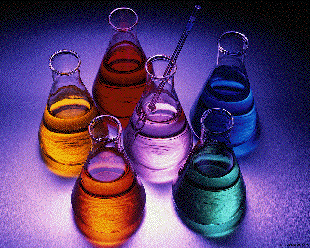On this day, we started our fifth unit: SOLUTION STOICHIOMETRY. What is solution stoichiometry you ask? This topic deals with quantities in chemical reactions taking place in solutions.

Solutions are homogeneous mixtures composed of a solute and a solvent. Remember that a solute is the chemical present in the lesser amount; it is whatever is dissolved. The solvent is the chemical present in the greater amount; it is whatever DOES the dissolving. Also recall that chemicals dissolved in water are called aqueous (NaCl(aq);H2SO4(aq)). Such reactions look like so: NaCl(s)-->NaCl(aq). Note that Sodium chloride does not actually REACT with water.
CONCENTRATION
How do you explain the concentration of a solution? Well, the concentration of a solution is the amount of solute in a given amount of solvent or solution. A concentrated solution contains a large amount of solute for the amount of solvent. This concentrated solution can be diluted by adding more solvent - solutions that have a relatively small amount of solute for the amount of solvent are called dilute.
Is there a limit to how concentrated a solution can be? The answer is yes, there is, because if you add too much sugar to water, some will sink to the bottom of the cup. A solution is called saturated when no more solute can be dissolved in it, that is, when it contains as much solute as can possible be dissolved under the existing conditions of temperature and pressure. An unsaturated solution is a solution that has less than the maximum amount of solute that can be dissolved. A supersaturated solution is a solution that contains a greater amount of solute than that needed to form a saturated solution; these are not stable solutions because, in some cases, some of the solute particles can escape from the solution and reform the pure solute.

Concentration can be expressed in many different ways: g/L, mL/L, % by volume, % by mass, and mol/L. However, the most common is mol/L, which is also called molarity (M). To determine molarity, divide the number of moles of solute by the number of liters of solution. MOLARITY = MOLES / VOLUME Molality is the number of moles of solute dissolved in each kilogram of solvent.Mole Fractions are the number of moles of one component divided by the total number of moles in the solution.
Molarity was the focus of today's lesson. Note that the capital -m, M, means mol/L. Also, square brackets, [], mean "concentration of." For example, [BaCl2] = 3.2M, or the concentration of Barium chloride is 3.2mol/L.
To explain the effect of concentration, Mr. Doktor mixed two different solution of calcium carbonate (chalk) and hydrochloric acid. One reacted faster than the other, because of a higher concentration.

- A solution contains 0.45 moles of NaCl in 4.2L. What is the molarity of the solution?
0.45mol/4.2L = 0.1071 or 0.11M
- 5.6g of NaCl is dissolved in enough water to make 170mL of solution. What is the molarity of the solution?
5.6g x 1mol/58.5g x 1/0.170L = 0.5631 or 0.56M
- Determine [NaCl] if 6.62g of NaCl is dissolved in 100mL of water.
6.62g x 1mol/58.5g x 1/0.100L = 1.1316 or 1.13mol/L
- To produce 32.0g of NaCl, what volume of 14.2M NaCl would be needed?
1L/14.2mol x 1mol/58.5g x 32.0g = 0.03852L or 0.0385L
Next time: Molarity & Stoichiometry!

No comments:
Post a Comment